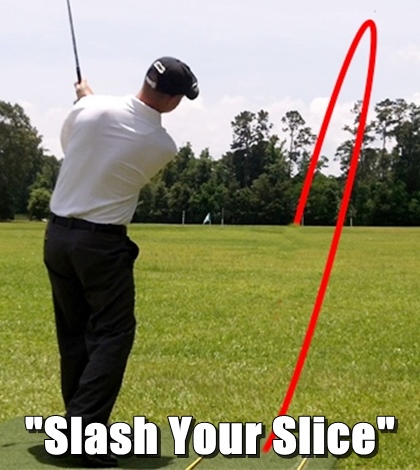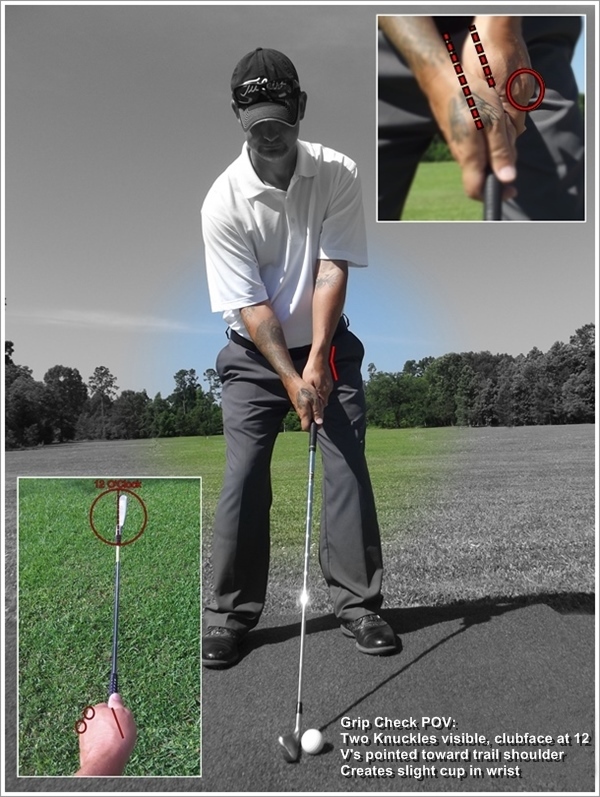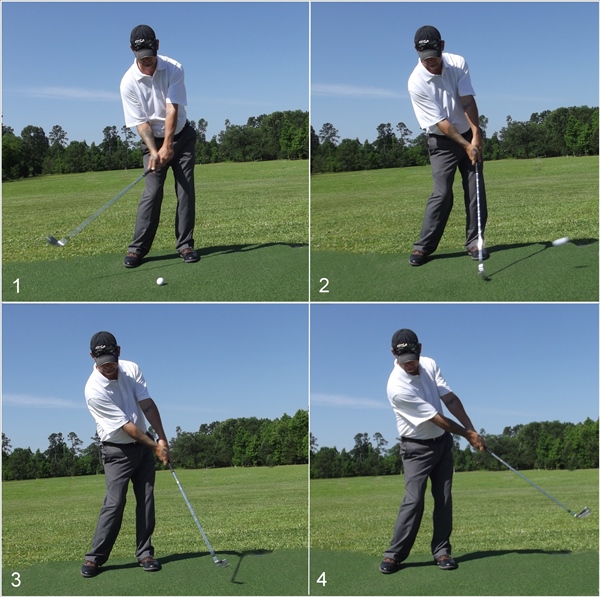Instruction
Slash Your Slice Part 1: Club face control

Operating an instruction facility that is also a driving range provides me with the opportunity to view shot patterns not only from the tee line, but also from the landing zone.
I regret to report that the slice side of my range sees too much action from golfers who do not know how make the necessary corrections and change the way their ball is curving.
I am going to dedicate my next three articles to addressing this all too common problem and give you the tools to begin controlling your ball flight.
Obviously, the big problem is that the ball is curving uncontrollably to the right for right-handed players and uncontrollably to the left for left-handed players. We are going to jump right in and take aggressive measures to change this frustrating shot shape and immediately make the ball curve in the opposite direction of your slice. In Part 1 of this article series, we will be working primarily on club face control.
There are many nuances involved with each golfers pre-swing conditions, so I will be speaking in generalities. It will be up to you to view your own procedure and make adjustments on an as-needed basis.
Check your grip
Position the lead hand so that at least two knuckles are visible from your perspective when the club is held parallel to the ground and the leading edge is pointing at 12 on a clock. Almost all of the golfers that I work with who are fighting a slice have a lead hand grip that is much too weak.
Check your alignment
Lay down an alignment rod pointing at a target. Set your feet, knees, hips, forearms and shoulders square (parallel) to this target line. This seems easy enough, but pay close attention to your trail forearm and shoulder. The tendency is for these areas to open up in relation to the target line, as you reach over and across your chest to add your trail hand to the grip. This open-shoulder position can pre-set an outside-in swing.
Note: Golfers must set up square to a clearly defined target line, because everything they do with the club face is in direct relationship to this base line. Having this point of reference will make our changes much easier.
The Swing
Making the ball curve in the opposite direction of your slice requires that the club face is closing in relation to the target line. This means that the toe of the club will be rotating around the hosel.
I described the slice as “the ball curving uncontrollably.” Once the toe starts rotating around the hosel, the ball will begin to follow the path of the toe and immediately start curving in the opposite direction of your slice. This club face control will be a direct result of your lead hand and forearm action, which you are about to learn.
Club Face Isolation Drill
We are going to start slashing your slice by aggressively curving 7 iron shots that you’ll fly about 50 yards or so. Tee the ball up 0.25 inches, and try not to swing the club past parallel to the ground. Relax any tension in your lead arm as you swing through, and rotate your lead hand to palm up.
You will sense your lead forearm swiveling at the elbow as you begin rotating the back of your lead hand, prior to and through impact. Observe the club face’s leading edge in relation to the target line. The more your rotate the lead hand, the more the club face closes and the more the ball curves.
Since I cannot see your stroke, it’s up to you to decide when and how much face rotation is needed. During a session, I would continue to repeat the words “more and sooner” until we achieved the desired amount of curve.
Once the ball is curving properly, I want you to “grow and blend.” You will grow the length of your swing and blend the amount of face rotation that your stroke requires. As the swing gets longer and speed increases, the amount of “when and how much” will need to feel “more and sooner” at first. Let these two phrases be your mantra on the practice tee and success will follow.
Remember to remain aware of your pivot and keep the lead shoulder moving. The pivot will always serve as the engine of our swing. Having no pivot is OK for very small strokes and practice swings, as you learn to rotate the lead hand and forearm. But make sure you keep the body moving as you grow your swing (We will focus more on pivot action in Part 2 and 3).
If you were a true slicer prior to this article, you will now start hitting a pull draw and that’s OK. This is part of the progression and exactly what we were planning on. You must develop club face control first.
Yes, you are still swinging from outside-in, but if you follow my advice you will no longer being doing so with an open club face. If I started off by showing you how to swing on the proper path with your old club face action, you would be hitting the mother of all push shots. That is not much fun either, and counterproductive for a golfer who has been experiencing a slice.
We will soon begin getting your shots to start online in Part 2 of this series and after Part 3, that slice will be just a bad memory.
[youtube id=”1zxrr4VBK_A” width=”620″ height=”360″]
- LIKE1
- LEGIT0
- WOW0
- LOL0
- IDHT0
- FLOP0
- OB0
- SHANK0
Instruction
Clement: Laid-off or perfect fade? Across-the-line or perfect draw?

Some call the image on the left laid off, but if you are hitting a fade, this could be a perfect backswing for it! Same for across the line for a draw! Stop racking your brain with perceived mistakes and simply match backswing to shot shape!
- LIKE0
- LEGIT0
- WOW0
- LOL0
- IDHT0
- FLOP0
- OB0
- SHANK1
Instruction
The Wedge Guy: The easiest-to-learn golf basic

My golf learning began with this simple fact – if you don’t have a fundamentally sound hold on the golf club, it is practically impossible for your body to execute a fundamentally sound golf swing. I’m still a big believer that the golf swing is much easier to execute if you begin with the proper hold on the club.
As you might imagine, I come into contact with hundreds of golfers of all skill levels. And it is very rare to see a good player with a bad hold on the golf club. There are some exceptions, for sure, but they are very few and very far between, and they typically have beat so many balls with their poor grip that they’ve found a way to work around it.
The reality of biophysics is that the body moves only in certain ways – and the particulars of the way you hold the golf club can totally prevent a sound swing motion that allows the club to release properly through the impact zone. The wonderful thing is that anyone can learn how to put a fundamentally sound hold on the golf club, and you can practice it anywhere your hands are not otherwise engaged, like watching TV or just sitting and relaxing.
Whether you prefer an overlap, interlock or full-finger (not baseball!) grip on the club, the same fundamentals apply. Here are the major grip faults I see most often, in the order of the frequency:
Mis-aligned hands
By this I mean that the palms of the two hands are not parallel to each other. Too many golfers have a weak left hand and strong right, or vice versa. The easiest way to learn how to hold the club with your palms aligned properly is to grip a plain wooden ruler or yardstick. It forces the hands to align properly and shows you how that feels. If you grip and re-grip a yardstick several times, then grip a club, you’ll see that the learning curve is almost immediate.
The position of the grip in the upper/left hand
I also observe many golfers who have the butt of the grip too far into the heel pad of the upper hand (the left hand for right-handed players). It’s amazing how much easier it is to release the club through the ball if even 1/4-1/2″ of the butt is beyond the left heel pad. Try this yourself to see what I mean. Swing the club freely with just your left hand and notice the difference in its release from when you hold it at the end of the grip, versus gripping down even a half inch.
To help you really understand how this works, go to the range and hit shots with your five-iron gripped down a full inch to make the club the same length as your seven-iron. You will probably see an amazing shot shape difference, and likely not see as much distance loss as you would expect.
Too much lower (right) hand on the club
It seems like almost all golfers of 8-10 handicap or higher have the club too far into the palm of the lower hand, because that feels “good” if you are trying to control the path of the clubhead to the ball. But the golf swing is not an effort to hit at the ball – it is a swing of the club. The proper hold on the club has the grip underneath the pad at the base of the fingers. This will likely feel “weak” to you — like you cannot control the club like that. EXACTLY. You should not be trying to control the club with your lower/master hand.
Gripping too tightly
Nearly all golfers hold the club too tightly, which tenses up the forearms and prevents a proper release of the club through impact. In order for the club to move back and through properly, you must feel that the club is controlled by the last three fingers of the upper hand, and the middle two fingers of the lower hand. If you engage your thumbs and forefingers in “holding” the club, the result will almost always be a grip that is too tight. Try this for yourself. Hold the club in your upper hand only, and squeeze firmly with just the last three fingers, with the forefinger and thumb off the club entirely. You have good control, but your forearms are not tense. Then begin to squeeze down with your thumb and forefinger and observe the tensing of the entire forearm. This is the way we are made, so the key to preventing tenseness in the arms is to hold the club very lightly with the “pinchers” — the thumbs and forefingers.
So, those are what I believe are the four fundamentals of a good grip. Anyone can learn them in their home or office very quickly. There is no easier way to improve your ball striking consistency and add distance than giving more attention to the way you hold the golf club.
More from the Wedge Guy
- The Wedge Guy: Golf mastery begins with your wedge game
- The Wedge Guy: Why golf is 20 times harder than brain surgery
- The Wedge Guy: Musings on the golf ball rollback
- LIKE88
- LEGIT14
- WOW6
- LOL1
- IDHT0
- FLOP4
- OB1
- SHANK8
Instruction
Clement: Stop ripping off your swing with this drill!

Not the dreaded headcover under the armpit drill! As if your body is defective and can’t function by itself! Have you seen how incredible the human machine is with all the incredible feats of agility all kinds of athletes are accomplishing? You think your body is so defective (the good Lord is laughing his head off at you) that it needs a headcover tucked under the armpit so you can swing like T-Rex?
- LIKE0
- LEGIT3
- WOW2
- LOL0
- IDHT0
- FLOP0
- OB0
- SHANK2
-

 19th Hole2 weeks ago
19th Hole2 weeks agoJustin Thomas on the equipment choice of Scottie Scheffler that he thinks is ‘weird’
-

 19th Hole2 weeks ago
19th Hole2 weeks ago‘Absolutely crazy’ – Major champ lays into Patrick Cantlay over his decision on final hole of RBC Heritage
-

 19th Hole3 weeks ago
19th Hole3 weeks agoTwo star names reportedly blanked Jon Rahm all week at the Masters
-

 19th Hole2 weeks ago
19th Hole2 weeks agoReport: LIV Golf identifies latest star name they hope to sign to breakaway tour
-

 19th Hole3 weeks ago
19th Hole3 weeks agoNeal Shipley presser ends in awkward fashion after reporter claims Tiger handed him note on 8th fairway
-

 19th Hole2 weeks ago
19th Hole2 weeks agoBrandel Chamblee has ‘no doubt’ who started the McIlroy/LIV rumor and why
-

 19th Hole1 week ago
19th Hole1 week agoLET pro gives detailed financial breakdown of first week on tour…and the net result may shock you
-

 Equipment2 weeks ago
Equipment2 weeks agoJason Day on his recent switch into Srixon ZX5 and ZX7 Mk II irons





















Dave
Aug 27, 2013 at 4:21 pm
Hasn’t Trackman recently up-ended this conventional thinking? We now know that face angle in relation to swing path is what effects the initial direction of the ball whereas the swing path itself is what determines “side spin” (there is no such thing, but for sake of this it’s easier to understand). So if you have an inside out swing path but a club face that very closed relative to that path, it will produce a snap hook (a ball that starts straight or left due to face and curves left due to path). So slicers typically have an very open face relative to their swing path… usually this is an outside in swing, but not necessarily.
Not saying that you can’t cure a slice using the methods described above, but the physics behind it are reversed symantically.
DS
Jun 13, 2013 at 11:36 am
Wouldn’t you just be changing the starting direction of the golf ball by rotating the face in that manner? Ball starts where the face is pointed and curves depending on that face relative to the path. Rotation of the face isn’t what makes a ball curve.
Michael Howes
Jun 13, 2013 at 7:16 pm
What we are going for is not a subtle open or closed club face during impact interval. We are trying to learn a “closing” action controlled by the lead hand and forearm rotation, that sometimes has to feel like it is occurring very early in the downstroke. This is because most of the slicers that I see have a lead hand that is breaking down, flipping the club face high and vertical. Their lead arm is also pulling hard and breaking down at the elbow. So even though their club face may be closed in relation to path where the ball starts left then slices – they cannot control any type of “closing” or turn down. I’m sure you have played with many golfers who shoot in the 70’s by learning to aim way right, rotate the face and hit a pull down the fairway every time. Not an optimal true draw, but beats the heck out of a weak bunker shot action off of the tee.
Once we get to feeling how the toe wants to rotate around the hosel , then we can move on to other relationships. A good drill for slicers is to go out in the yard and hit some little 7 irons or wedges rotating your hand and forearm as described (You can hit whiffel balls, pinecones, etc.). The object will fly low and hooking. Now take the same club and make a vertical action by chicken winging the lead elbow and flipping the lead wrist up – not a very efficient action and this is what most slicers are up against. In Part 2 we will get more into plane, path, face relationships. Thanks for reading.